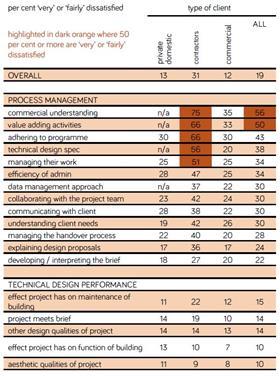Concerns centre on commercial nous and sticking to programmes
Architects get consistently lower satisfaction ratings from contractors compared with domestic or commercial clients and suffer across-the-board problems with process-management, according to a new survey.
A RIBA report called Working With Architects found that just 51% of contractors said they were either “very satisfied” or “fairly satisfied” with the work of their architects, compared with 76% of domestic clients and 73% for commercial clients.
Three-quarters of contractors said they were either “very” or “fairly” dissatisfied with architects’ commercial understanding, while 66% gave the same rating to architects’ value-adding activities and their ability to adhere to programmes.
The institution’s crunch of responses from around 1,000 clients surveyed identified process-management as a core area of dissatisfaction among contractors with just 30% of contractors saying they were “very” or “fairly” satisfied. The figure was 61% for domestic clients and 56% for commercial clients.
A breakdown of the process-management areas in which contractors were particularly dissatisfied included commercial understanding, value-adding activities, adhering to the programme and technical design specification.
RIBA president Jane Duncan said that while the survey’s overall findings showed clients were pleased with architects’ work, it was the anomalies and poorer ratings that should be a guide for future relationships.
“Contractors are a distinct market segment, but their satisfaction ratings for our process management skills fell below our self-imposed baseline,” she said.
“The next step is to respond positively with training and support. We also need to establish best methods for the RIBA to monitor how effectively we are improving over time.”
Her predecessor Stephen Hodder, who is also the institute’s client ambassador, said that while feedback from contractors was disappointing, it could be skewed by the process of assembling construction teams for particular jobs.
“The briefing process is often largely concluded by the time architects are novated to the contractor,” he said.
“Another issue is to do with clashing motivations. While architects are minded to consider a wide spectrum of concerns, contractors’ contractual focus is narrower.”
Hodder added that the survey data also flagged differences in satisfaction levels between different types of building.
He said clients in education were “distinctly less happy with the overall briefing than others”, while the health sector was “very satisfied” with brief development but much less satisfied that the resulting building met the brief.




























1 Readers' comment